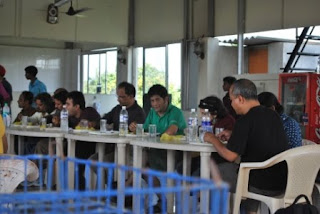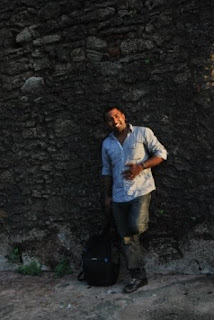














































There are three Udwadas for the artists in FALCAT camp; one, the Udwada in my curatorial note. Two, the Udwada that they see with their own eyes. Three, the Udwada in their personal interpretations.
‘This place holds a particular charm, which I am not able to explain in words,’ says Reji Arakkal, one of the youngest members in the camp. “I read your blog and then read your curatorial note. I am looking for what you have seen but I see what I cannot escape,’ he adds.
‘It is nostalgia. If you ask me to give you a work, I may make work out of Tarkovsky’s Nostalgia and give you right away,’ says Prasad Raghavan, whose works are inspired by the classical movies.
The charm of nostalgia, the charm of ruins, the attraction of the left-over, the secret of the closed doors, the allurement of dilapidation, the threat of collapse, the waves of eternity, the non-extinguishable fire of faith, the slow pace of a strange life: Udwada holds it all.
We are all there in Udwada at ten O’clock in the morning. Twenty nine friendly invaders armed with cameras and eyes wide open in wonderment move along in the by-lanes of Udwada.
A sleepy village, disturbed by the movements of visitors, changes position in its own perennial slumber and goes back to sleep.
The artists have split into many teams. And they are not allowed to visit the Fire temple of Ahur Mazda, the pilgrim center of Parsees, where the fire that they had brought in the 10th Century AD from Iran still burns. But they can visit the replica of its sanctum sanctorum at the museum in Udwada, currently maintained by the Government of Gujarat.
A few of us get lost as we follow a wrong sign board and we look around for some people who can show us the way to the museum. We meet two women, who look like vegetable vendors.
‘To that way,’ one of the women gestures. We don’t find any ‘way’ where she points. We walk on and find an auto-rickshaw driver.
‘Museum?’ he asks unconvinced. ‘There is no museum here.’
By this time I am accustomed to those people who tend to give wrong directions or no directions at all.
We keep walking. Then the auto-rickshaw comes back to us and the driver tells us to take a right turn and follow the sign boards.
The Museum of Parsees is located at the northern end of Udwada. Along the way, we find residences in various stages of decay.
Wherever there is degeneration and collapse, nature comes into play. It embroiders the decaying structures with flowery creepers. Anywhere in the world abandoned places have the same greenery of celebration- the greenery that houses ethereal spirits and slimy creatures of the earth.
Mango trees are in every courtyard of ruin as if they were still showering fertility and prosperity to whatever they are guarding. When things are degenerating mango trees can do nothing but shower the process of degeneration with blessings. Nature ultimately does not discriminate.
One of the dilapidated structures houses a sculpture studio. Artists are curious. They get in there and find the fiber glass casts of the Ahur Mazda temple architectural parts.
‘I don’t know where it goes. But we get orders to make it,’ the boy who presides over the fiber casts informs us. He says that the studio in ruin was the property of a Parsee family, which had shifted to Mumbai. Now they have sold it to another Parsee family. Details….he does not know.
Here no property is sold to a non-Parsee person. We find a huge wasteland with a lonely sing board saying that it belongs to the Tata Group.
George Martin and Babu Eshwar Prasad, who zoom past us on their motor bike find a place with a board, ‘Babu Artist’. But nobody is there in the building and nobody knows who runs Babu Artist’s studio.
Neglecting the caretaker’s admonitions we get into a broken structure that leads to the sea shore. Prasad Raghavn climbs to its first floor and poses for a photograph, which, he says, would go into a Gucci advertisement.
Finally we reach the Museum. A humble structure filled with visual and textual histories of the Parsees.
Parsees, the followers of Zorashtrianism, came to the Indian shore in 11th century AD and finally settled in Udwada.
They have a distinctive culture and tradition. The items in the museum tell us the history through textual and visual narratives. A three room structure holds our attention than any other museum in India would hold.
Parsees have distinct birth and death ceremonies. The Tower of Silence, where the Parsees leave their dead to be consumed by the vultures becomes a major attraction for all of us. Death attracts as much as it repels.
A local artist has made visual and textual narratives on these ceremonies. There is a mutation of local and scriptural narrative styles in these albums. We try to identify the familiar and the mutant. The hybridization of culture is quite evident here.
The audio visual room in this museum is very interesting. There are four small showcases and a few books in them, which are secured behind strong locks.
In the small canteen there we have black tea, which obviously tastes different from the black tea that you get from elsewhere.
We have made previous arrangements for a complete Parsee lunch at the Aatish Hotel, one of the rare Parsee enterprises in Udwada, a place where you find small sandal wood pieces as the only merchandise.
Parsee menu includes both vegetarian and non-vegetarian dishes. Vegetarian dish contains a sort of vegetable cuchori, salad, roti and paneer. In non-vegetarian you have chicken cuchori, dhansak (mutton gravy and rice), fish fillets and fish smoked in paper.
Inside the coco-cola racks we find similar cola bottles but with a different brand name, ‘Santa’. It does not taste like a cola, instead it tastes like Jal Jeera; a local cola but well packaged. A few of the artists become addicted to Santa. Later they would bring some Santa to Cidade De Daman and mix it up with Rum and drink.
After lunch a set of artists head towards Daman Fort again for extensive photo shoot.
Later at night George Martin and Rupa Paul do their power point presentations.
George Martin’s work that refers to Joseph Beuys’ performance spurs off a series of questions about art history and the use of materials.
K.M.Madhusudhanan and Rajan Krishnan activate the discussion by citing several examples from the life and works of Joseph Beuys.
The discussion continues till early morning 3 O’ clock.
Joseph Beuys can still flutter a few feathers with his sheer conceptual strength. That’s the strength of art history or literature built around art.
Art without its literature is bound to die, I tell myself before I slip into sleep rocked by the lullaby of art historical discourse by my spirited friends.
No comments:
Post a Comment